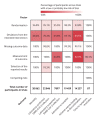Prophylaxis against covid-19: living systematic review and network meta-analysis
- PMID: 33903131
- PMCID: PMC8073806
- DOI: 10.1136/bmj.n949
Prophylaxis against covid-19: living systematic review and network meta-analysis
Abstract
Updates: This is the second version (first update) of the living systematic review, replacing the previous version (available as a data supplement). When citing this paper please consider adding the version number and date of access for clarity.
Objective: To determine and compare the effects of drug prophylaxis on severe acute respiratory syndrome coronavirus virus 2 (SARS-CoV-2) infection and coronavirus disease 2019 (covid-19).
Design: Living systematic review and network meta-analysis (NMA).
Data sources: World Health Organization covid-19 database, a comprehensive multilingual source of global covid-19 literature to 4 March 2022.
Study selection: Randomised trials in which people at risk of covid-19 were allocated to prophylaxis or no prophylaxis (standard care or placebo). Pairs of reviewers independently screened potentially eligible articles.
Methods: After duplicate data abstraction, we conducted random-effects bayesian network meta-analysis. We assessed risk of bias of the included studies using a modification of the Cochrane risk of bias 2.0 tool and assessed the certainty of the evidence using the grading of recommendations assessment, development and evaluation (GRADE) approach.
Results: The second iteration of this living NMA includes 32 randomised trials which enrolled 25 147 participants and addressed 21 different prophylactic drugs; adding 21 trials (66%), 18 162 participants (75%) and 16 (76%) prophylactic drugs. Of the 16 prophylactic drugs analysed, none provided convincing evidence of a reduction in the risk of laboratory confirmed SARS-CoV-2 infection. For admission to hospital and mortality outcomes, no prophylactic drug proved different than standard care or placebo. Hydroxychloroquine and vitamin C combined with zinc probably increase the risk of adverse effects leading to drug discontinuation—risk difference for hydroxychloroquine (RD) 6 more per 1000 (95% credible interval (CrI) 2 more to 10 more); for vitamin C combined with zinc, RD 69 more per 1000 (47 more to 90 more), moderate certainty evidence.
Conclusions: Much of the evidence remains very low certainty and we therefore anticipate future studies evaluating drugs for prophylaxis may change the results for SARS-CoV-2 infection, admission to hospital and mortality outcomes. Both hydroxychloroquine and vitamin C combined with zinc probably increase adverse effects.
Systematic review registration: This review was not registered. The protocol established a priori is included as a supplement.
Funding: This study was supported by the Canadian Institutes of Health Research (grant CIHR-IRSC:0579001321).
© Author(s) (or their employer(s)) 2019. Re-use permitted under CC BY-NC. No commercial re-use. See rights and permissions. Published by BMJ.
Conflict of interest statement
Competing interests: All authors have completed the ICMJE uniform disclosure form at www.icmje.org/coi_disclosure.pdf and declare: BS reports receiving funding from PIPRA AG (www.pipra.ch) to conduct a systematic review and individual patient data meta-analysis on predictors of postoperative delirium in elderly people in 2020-21; funding from Mitacs Canada, Accelerate internship in partnership with Nestlé Canada to support his graduate student stipend from 2016 to 2018. Mitacs is a national, not-for-profit organisation that has designed and delivered research and training programmes in Canada, working with universities, companies, and both federal and provincial governments; and funding from the International Life Sciences Institute (ILSI)-North America to support his graduate work for his 2015 academic year. In 2016-17, BS worked part-time for the Cornerstone Research Group (CRG), a contract research organisation. The ILSI funding and being employed by CRG are outside the required three year period requested on the ICJME form. ML reports personal fees and non-financial support from Sanofi, grants and personal fees from Seqirus, and personal fees from Pfizer and Medicago outside the submitted work; and is co-investigator on an Anti-Coronavirus Therapies (ACT) randomised trial of covid-19 treatment. LG reports grants from the Ministry of Science and Technology of China, outside the submitted work. All other authors report no financial relationships with any organisations that might have an interest in the submitted work in the previous three years and no other relationships or activities that could appear to have influenced the submitted work.
Figures
Comment in
-
Update to living systematic review on prophylaxis against covid-19.BMJ. 2023 Mar 23;380:688. doi: 10.1136/bmj.p688. BMJ. 2023. PMID: 36958734 No abstract available.
References
-
- Johns Hopkins University. Coronavirus Resource Center. 2020 https://coronavirus.jhu.edu/map.html.
-
- Centers for Disease Control and Prevention. SARS-CoV-2 Variant Classifications and Definitions. 2021. www.cdc.gov/coronavirus/2019-ncov/cases-updates/variant-surveillance/var....
Publication types
MeSH terms
Substances
LinkOut - more resources
Full Text Sources
Medical
Miscellaneous



